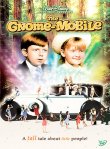This movie was actually something of a disappointment for me. It moved rather slowly, and to be honest I was kind of glad when it ended. The story is about this rich lumber owner named Mr. Mulrooney, and he's having his grand kids from England come over to visit him. The grandchildren are the kids from Marry Poppins, that's actually how they're introduced too. So Mulrooney takes the kids to a forest he owns for a picnic and while he and the grandson set up camp, the granddaughter goes off for a walk and comes upon this gnome who asks for her help. She rushes back to get her grandfather and brings him back to the gnome. As it turns out the gnome's grandfather is dying. Gnomes only die if they've given up the will to live and the grandfather has given up the will to live because he and his grandson are the last gnomes in the forest and he will never see his grandson married. The grandfather offers to take the two to another forest where there might be more gnomes and they agree to go with them to this forest in the grandfather's car, now effectively, the gnome mobile. The party has to stop off at a hotel for the night and grandfather gnome gets angry at Mr. Mulrooney who gets angry enough to call off the trip and storms out of the room. A travelling freak show owner happens to pass by as this happens and see the gnomes. He then proceeds to kidnap them as they will make for an interesting new attraction. When Mr. Mulrooney finds out the gnomes are missing he calls his security team to help find them, but when his employee hears what he has to say he thinks he's gone mad and has him put in an insane asylum. His grandkids break him out and they go retrieve the gnomes and get to the forest, where the young gnome finds some girl gnomes to fight over him and they all live happily ever after.
The acting in this movie was horrible. It was so forced and stereotyped and fake, it was almost painful to watch. This film is by Disney, and because of that I was quite disappointed with the overall quality. Darby O'Gill and the Little People was also a Disney film about faeries and it was quite well done so we know they are capable, but this is definitely b film material. The songs were cheesy, but I'm less distraught about that as many b film songs are usually quite poorly done. Many parts of the plot weren't given enough explanation. Some scenes seemed to flow along as they did because it would best suit what happened next and not so much because it was a logical scene that fit into an overall plot. Some of the actions taken by people in response to the gnomes, for example, were too extreme or convenient to be taken seriously by the audience. The special effects are pretty good and the guy who does the voice for the Mad Hatter in Alice in Wonderland makes an appearance as one of the gnomes, I think that's all that can be said for this movie. All in all, ok for an initial viewing, but definitely not a keeper.



On a completely unrelated side note for this last picture, I spent at least 10 minutes going through the last scene looking for a decent picture of all the characters, but that Mr. Mulrooney, what a face. He's really animated when he's singing, but when you pause the movie almost every face he makes is unflattering. In a funny way, like when you pause a movie and the person is in mid-word and has a funny face... but all of his faces were like that. It was funny.
Here is a fan vid that shows clips from all the significant parts of the movie















